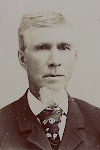No doubt that the Livingston Lord Satterthwait, as a U.S. diplomat to Copenhagen, was conducting meetings with Thule Air Force Base command personnel around the nature of U.S. nuclear arms in Greenland. He was likely communicating issues expressed by the Denmark government over operations of the then six year-old base. The specific mission of delivering the Inuit women back to her village after surgery at the military hospital was a “photo-op” to demonstrate to the native people and to the Denmark government a very positive benefit of having a U.S. base with a hospital in far northwestern corner of the country.
Forty-Four Years Later: A Memorial

American Embassy in Copenhagen Denmark. Building Opened in 1954. Picture from http://denmark.usembassy.gov/
In 2003 The U.S. State Department honored the memories of Col. Hogan and diplomat Satterthwaite. A memorial plaque at the Embassy in Copenhagen was unveiled in a ceremony on July 14th 2003. It notes the sacrifice these men made to our nation under the Cold War era. Ambassador Stuart A. Bernstein, who presided at the unveiling, said that the families of the men killed should comfort in knowing their loved one helped advance the cause of freedom during the Cold War. Several members of Satterthwait’s family, including his widow, attended the event. It was reported that members of Col. Hogan’s family would have been invited guests as well, but State Department officials were unable to locate them. [see footnote].
At this writing it is unknown to this author if descendants of the Hogan family have yet become aware of the 2003 honor bestowed by the State Department regarding James’ sacrifice to our nation.
❧
Footnote: Before Thule Air Force Base was built in the early 1950s the United States (under the Franklin Roosevelt administration) attempted to buy Greenland from Denmark. While an offer was made, apparently the Danes had no interest in selling, and so the offer went unanswered. Perhaps as a compromise to outright sale of the country, Copenhagen agreed to allow the U.S. to build a base in the far northwestern corner of the country.
❧
Footnote: Thule means the most northerly region of the habitable world to ancient Greek geographers.
❧
Footnote: The building of Thule AFB was a major secret. Called project Blue Jay, 12,000 men, based out of Navy ships send from Virginia, built much of Thule during the summers of 1951, ’52 and ‘53. It was an amazing feat of engineering, which went unreported, due to its secret military nature. It has been compared to the same amount of effort taken to build the Panama Canal. Nearly all of Greenland is tundra and Thule Base and airstrip is built entirely on permafrost, making installation of stable footings a challenge. Thule is also “locked-in” by sea ice nine months out of the year, making construction a race in getting supplies to the project. Ships must arrive soon as the ice is thin and must depart before thick ice forms again curtaining shipments for another nine months.
❧
Footnote: Regarding the State Department’s difficulty in locating immediate family of James Hogan in 2003: James' wife, Evelyn, is believed to be living, but is known to have married twice after her husband James’ death in 1959. Her surnamed changed in each of these marriages. James and Evelyn Hogan’s daughter Eve, age 13 at the time her father’s death, is living but has also married twice, changing her surname with each marriage. In addition, both mother and daughter have lived away from Ashland Wisconsin for decades. James’ father Francis died 10 years prior to James’ death. His mother Evaline died in 1969. And James’ two brothers had also passed before 2003; Jack in 1966 and Mickey in 1994.
❧
Footnote: While the helicopter crash and death of seven men in 1959 is tragic it is not the most notable aircraft crash associated with Thule Air Base. A near nuclear disaster occurred near Thule on January 21, 1968. A United States Air Force B-52 bomber was carrying four hydrogen bombs during a Cold War alert mission was flying a figure-eight pattern over Baffin Bay Greenland. An in-flight cabin fire started. It became out of control forcing the seven members on board to abandon the aircraft before they could execute an emergency landing. Six of the crew ejected safely, but one who did not have an ejection seat was killed while exiting the bomber. The then unmanned B-52 crashed on the sea ice in North Star Bay 7.5 miles west of Thule Air Base causing the nuclear payload to break apart and disperse radioactive material across three miles of sea ice. A clean-up effort was immediately launched by the United States and Denmark to recover the radioactive material. Part of one of the nuclear weapons was never accounted for and continues to be source of environmental / weapons debate in Danish politics.
❧
Footnote: Ducklow Pedigree: James Francis Hogan > Evaline Josphine Good > James Walter Good > Mary Ann Ducklow Good > Thomas and Elizabeth Ducklow
❧
Sources:
Ironwood Daily Globe, Ironwood, Michigan, August 28, 1959, Page 1 “Tribute is Paid Ashland Officer Thule Copter Crash Kills Two Badger Men”
Oshkosh Daily Northwestern, Oshkosh, Wisconsin, Saturday, August 29, 1959, “Officer Killed in Helicopter Crash Had Cousin in City”
American Foreign Service Association News, October 2003, Page 3, http://www.afsa.org/fsj/oct03/AFSANEWSOct2003.pdf, “1959 Thule Helicopter Crash Victims Remembered”
United States Depart of State, State Magazine, October 2003, Page 8, http://www.state.gov/documents/organization/25073.pdf, “Never Too Late to Remember”
Thule Air Base, http://en.wikipedia.org/wiki/Thule_Air_Base
1968 Thule Air Base B-52 Crash, Wikipeda, http://en.wikipedia.org/wiki/1968_Thule_Air_Base_B-52_crash
Greenland, Wikipedia, http://en.wikipedia.org/wiki/Greenland
Time Magazine, January 27, 1947, National Affairs: Deepfreeze Defense http://www.time.com/time/magazine/article/0,9171,778870,00.html
Thule Air Base, http://wapedia.mobi/en/Thule_Air_Base
❧






